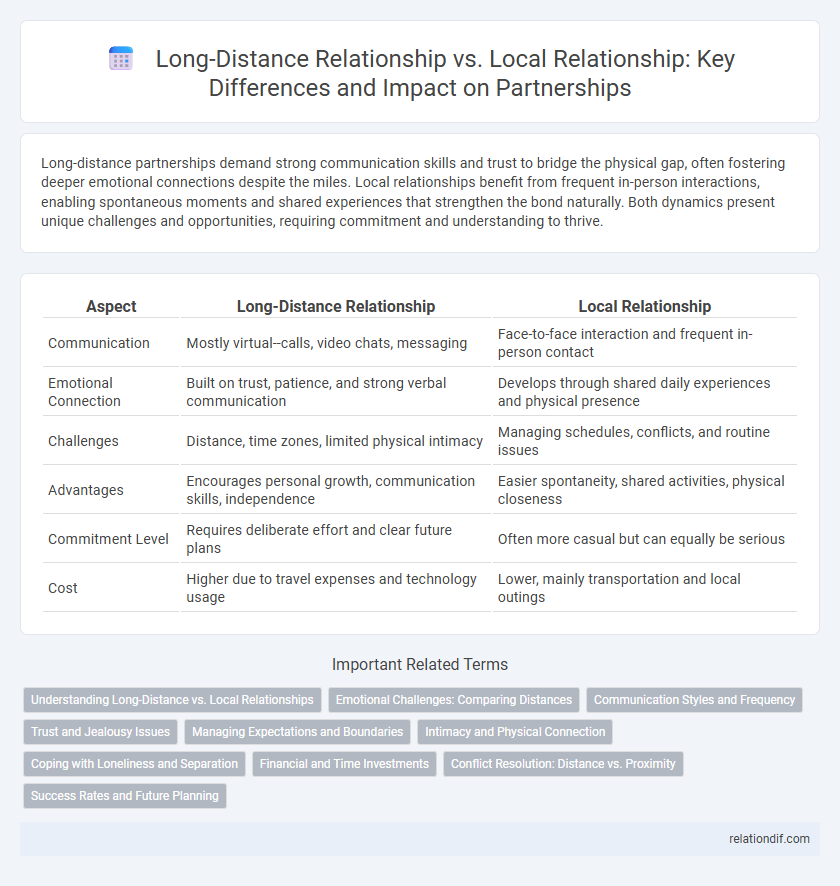Long-distance partnerships demand strong communication skills and trust to bridge the physical gap, often fostering deeper emotional connections despite the miles. Local relationships benefit from frequent in-person interactions, enabling spontaneous moments and shared experiences that strengthen the bond naturally. Both dynamics present unique challenges and opportunities, requiring commitment and understanding to thrive.
Table of Comparison
| Aspect | Long-Distance Relationship | Local Relationship |
|---|---|---|
| Communication | Mostly virtual--calls, video chats, messaging | Face-to-face interaction and frequent in-person contact |
| Emotional Connection | Built on trust, patience, and strong verbal communication | Develops through shared daily experiences and physical presence |
| Challenges | Distance, time zones, limited physical intimacy | Managing schedules, conflicts, and routine issues |
| Advantages | Encourages personal growth, communication skills, independence | Easier spontaneity, shared activities, physical closeness |
| Commitment Level | Requires deliberate effort and clear future plans | Often more casual but can equally be serious |
| Cost | Higher due to travel expenses and technology usage | Lower, mainly transportation and local outings |
Understanding Long-Distance vs. Local Relationships
Long-distance relationships demand strong communication skills, trust, and emotional resilience to maintain connection despite physical separation, whereas local relationships benefit from frequent face-to-face interactions and shared daily experiences. Understanding the unique challenges and advantages of each dynamic helps partners adapt their expectations and strategies to foster intimacy and commitment. Studies show that couples in local relationships report higher satisfaction due to proximity but long-distance couples often develop deeper emotional bonds through intentional communication.
Emotional Challenges: Comparing Distances
Long-distance relationships often face heightened emotional challenges such as feelings of loneliness, trust issues, and communication barriers due to physical separation. In contrast, local relationships benefit from daily face-to-face interactions, fostering stronger emotional bonds and immediate conflict resolution. Studies show that couples in local relationships report higher satisfaction levels, while long-distance partners must rely heavily on digital communication to maintain emotional intimacy.
Communication Styles and Frequency
Long-distance relationships rely heavily on digital communication tools such as video calls, messaging apps, and social media to maintain emotional intimacy despite physical separation. Communication frequency in these partnerships tends to be more deliberate and scheduled, often involving longer, more meaningful conversations to compensate for the lack of in-person interaction. In contrast, local relationships benefit from spontaneous and varied communication styles including face-to-face interactions, nonverbal cues, and shared daily activities that naturally enhance connection and responsiveness.
Trust and Jealousy Issues
Trust plays a crucial role in both long-distance and local relationships, but it requires different dynamics to maintain stability. Long-distance relationships demand heightened communication and emotional transparency to counteract the physical absence that can fuel jealousy issues. In contrast, local relationships often face jealousy challenges rooted in day-to-day interactions and proximity, requiring consistent reassurance and mutual respect to preserve trust.
Managing Expectations and Boundaries
Managing expectations in long-distance relationships requires clear communication and mutual understanding of availability and emotional needs, whereas local relationships benefit from more spontaneous interactions and immediate support. Defining boundaries is crucial in both scenarios, with long-distance partners often establishing guidelines on communication frequency and trust, while local couples may focus on balancing personal space and shared time. Setting realistic goals and respecting each other's limits strengthens commitment and reduces misunderstandings in both types of partnerships.
Intimacy and Physical Connection
Long-distance relationships require intentional communication to maintain emotional intimacy despite physical separation, often relying on virtual interactions to bridge the gap. Local relationships benefit from regular face-to-face contact, fostering spontaneous physical connection and shared experiences that naturally enhance bonding. Sustained physical presence in local partnerships strengthens attachment through nonverbal cues and physical touch, which are crucial for deepening intimacy.
Coping with Loneliness and Separation
Coping with loneliness in long-distance relationships requires intentional communication, trust-building, and shared goals to maintain emotional closeness despite physical separation. Local relationships benefit from frequent in-person interactions that naturally alleviate feelings of isolation and strengthen partnership bonds. Both dynamics demand tailored coping strategies to address challenges unique to distance, fostering resilience and connection.
Financial and Time Investments
Local relationships typically require less financial investment in travel and allow for more spontaneous shared experiences, maximizing time efficiency. Long-distance relationships often demand higher costs for transportation and communication tools, alongside meticulous time management to maintain regular contact. Balancing these investments is crucial for sustaining emotional connection and relationship growth over time.
Conflict Resolution: Distance vs. Proximity
Conflict resolution in long-distance relationships often relies heavily on digital communication tools, requiring couples to develop strong verbal skills and patience to navigate misunderstandings. In local relationships, immediate physical presence allows for quicker emotional reconciliation and non-verbal cues, which can reduce prolonged conflicts and enhance empathy. Proximity facilitates spontaneous interactions that help couples address issues in real-time, while distance necessitates intentional and scheduled conversations to maintain connection and resolve disputes.
Success Rates and Future Planning
Long-distance relationships often face lower success rates compared to local relationships due to communication barriers and limited physical presence. However, couples who prioritize future planning and set clear goals tend to improve their chances of long-term success despite distance. Local relationships benefit from daily interactions and shared experiences, which enhance emotional bonding and facilitate joint future planning.
long-distance relationship vs local relationship Infographic

 relationdif.com
relationdif.com